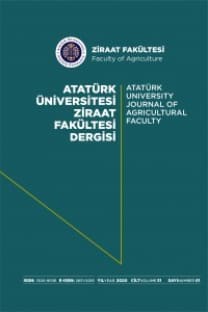Birlikte Ekimin Kır Çeltiği (Oryza sativa L. var. zambales) ve Yer Fıstığı (Arachis hypogaea L.)’nın Gelişme ve Verim Performansı Üzerine Etkisi
Birlikte ekim, birim zamanda birim alan başına verimliliği artırmanın bir yoludur. Bu çalışmanın amacı: (1) birlikte ekim şeması altında kır çeltiği ve yer fıstığının büyümesi ve verimi üzerindeki dikim zamanlamasının etkilerini değerlendirmek, (2) optimum verim verecek kır çeltiği ve yer fıstığının uygun ekim zamanlamasını belirlemek ve (3) birlikte ekim planı kapsamında kır çeltiği ve yer fıstığı üretiminin karlılığını değerlendirmek. Deneme alanı tesadüf blokları deneme desenine göre üç tekerrürlü olarak kurulmuştur. Uygulamalar şu şekilde yapılmıştır: T1 —kır çeltiği+aynı anda ekilen yer fıstığı, T2—yer fıstığından 1 hafta önce ekilen kır çeltiği, T3—yer fıstığından 2 hafta önce ekilen kır çeltiği, T4—kır çeltiğinden 1 hafta önce ekilen yer fıstığı ve T5—kır çeltiğinden 2 hafta önce ekilen yer fıstığı. Sonuçlar, kır çeltiğinin yer fıstığından 2 hafta önce (T3) ve yer fıstığı ile aynı anda (T1) ekildiğinde, diğer uygulamalara göre daha erken hasat olgunluğuna ulaştığını göstermiştir. Benzer şekilde, T3 ve T5 uygulamalarından en ağır salkımlar elde edilmiştir. Yine, kır çeltiğinden 2 hafta önce ekilen yer fıstığı var. BPI-Pn9 diğer uygulamalardan daha önce çiçeklenmiş ve olgunlaşmıştır. En yüksek alan ve alan zaman eşdeğer oranları sırasıyla 1,50 ve 2.02 olarak T% (kır çeltiğinden 2 hafta önce ekilen yer fıstığı) uygulamasından elde edilmiştir. En yüksek toplam verim (2,42 t/ha kır çeltiği + 1,47 t/ha yer fıstığı)) T5 uygulamasından elde edilmiş ve bu da PhP86.867,02/ha ile en yüksek brüt kar sağlamıştır.
Anahtar Kelimeler:
Alan zaman eşdeğer oranı, gelişme ve verim, birlikte ekim planı, ekim zamanı
Influence of Timing of Planting on the Growth and Yield Performance of Upland Rice (Oryza sativa L. var. Zambales) and Peanut (Arachis hypogaea L.) Intercrop
Intercropping is one way of increasing productivity per unit area per unit time. This study aimed to 1) evaluate the effects of timing of planting on the growth and yield of upland rice and Peanut under the intercropping scheme; 2) determine the appropriate timing of planting upland rice and Peanut that would give optimum yield, and 3) assess the profitability of upland rice and peanut production under the intercropping scheme as influenced by the timing of planting. The experimental area was laid out in a Randomized Complete Block Design (RCBD) with three replications. The treatments were as follows: T1 - upland rice + Peanut planted simultaneously, T2 - Upland rice planted one (1) week ahead than Peanut, T3 - Upland rice planted two (2) weeks ahead than Peanut, T4 - Peanut planted one (1) week ahead than upland rice, and T5 - Peanut planted two (2) weeks ahead than upland rice. Results showed that upland rice planted two (2) weeks ahead of Peanut (T3) and those planted simultaneously with Peanut (T1) headed and matured earlier than the other treatments. Likewise, T3 and T5 obtained the heaviest panicles per 0.50 linear meter. Similarly, peanut var. BPI-Pn9 planted two weeks ahead of upland rice (T5) flowered and matured earlier than the other treatments. The highest LER and ATER values of 1.50 and 2.02, respectively, were obtained from T5 (Peanut planted two (2) weeks ahead than upland rice). The highest combined yield of upland rice (2.42t ha-1) and Peanut (1.47t ha-1) was also obtained from T5, which resulted in the highest gross margin of PhP86,867.02 ha-1.
Keywords:
Area time equivalent ratio, intercropping scheme, land equivalent ratio Alan zaman eşdeğer oranı, gelişme ve verim, birlikte ekim planı, ekim zamanı,
___
- Alcober EL, Ratılla MD, Capuno OB and Valenzona JS. 2014. Evaluation of Different Cropping Systems for Marginal Uplands in Inopacan, Leyte. Visayas State University Visca, Baybay City, Leyte. Annals of Tropical Research, 36:124-138
- Daniel HS. 2004. Weed management under different patterns of sunflower-soybean intercropping. Journal of Central European Agriculture. 10(1): 41-52
- Dhima KV, Lithourgidis AA, Vasilakoglou IB and Dordas CA. 2007. Competition indices of common vetch and cereal intercrops in two seeding ratio. Field Crop Res. 100: 249-256
- Dordas AR. 2011. Intercropping: Land equivalent ratios, light interception, and water use in annual intercrops in the presence or absence of in-crop herbicides. American Agronomy Journal, 100:1145-1154
- Jeruto SL. 2017. Structure of weed communities occurring in monoculture and intercropping of field pea and barley. Agric. Ecosyst. Environ. 109: 48-58
- Landon JR. 1991. Booker Tropical Soil Manual. Longman Scientific and Technical/Booker Tate, Harlou. pp478
- Mandal KM. 2014. Evaluation of Cereal-Legume Intercropping Systems through Productivity and Competition Ability. Asian Journal of Science and Technology 5(3): 233-237
- NCT Manual for Rice. 2008. Guidelines in conducting National Cooperative Testing in Field Legumes. Field legumes Technical Working Group. BPI – BUREAU OF PLANT INDUSTRY. Quezon, City. Revised 2014
- Ndunguru BS, Karel AK, and Lakhanı DA. 1980. Intercropping maize on cowpea effect of plant population on insect pest and seed yield. Proceedings on semi-arid areas Mongro, Tanzania. 102-109 pp
- Sarcol BP and Cagasan UA. 2016. Performance of Peanut (Arachis hypogaea) as Influenced by Time of Planting Sweetpotato (Ipomea batatasL.) as intercrop. Annals of Tropical Research 38, 122-133.
- Tosas DM. 1988. Performance of sweet corn at the varying time of mungbean intercropping. Undergrad thesis. LSU, ViSCA, Baybay Leyte. 20 pp
- Zhang FN and Long AL. 2003. Using competitive and facilitative interactions in the intercropping systems enhances crop productivity and nutrient-use efficiency. Plant and Soil, 248, 305–312
- ISSN: 1300-9036
- Yayın Aralığı: Yılda 3 Sayı
- Yayıncı: AVES Yayıncılık
